Gregory A. Fournier's Blog, page 50
October 3, 2012
In the Shadow of the Water Tower - Revisited
 Detroit's rock and roll blogger extraordinaire, Kim Maki (Retrokimmer.com), has agreed to help me in my quest for information on the John Norman Collins' murders of the late Sixties in Ypsilanti, Michigan.
Detroit's rock and roll blogger extraordinaire, Kim Maki (Retrokimmer.com), has agreed to help me in my quest for information on the John Norman Collins' murders of the late Sixties in Ypsilanti, Michigan.Kim is a longtime resident of Ypsilanti who remembers the dark cloud that hung over Washtenaw County for two long years when seven young women were sexually abused and brutally murdered. See her video on the Michigan Murder Landmarks in the link below.
Contact me with any information you can share on these matters. Every piece of the puzzle is important. Your confidentiality will be respected.
www.gregoryafournier@gmail.com
or mail me at:
FornologyPO Box # 712821 Santee, CA 92072-2821
http://www.retrokimmer.com/2012/09/new-michigan-murders-book-project.html
Published on October 03, 2012 20:04
September 30, 2012
In the Shadow of the Water Tower - The John Norman Collins Story
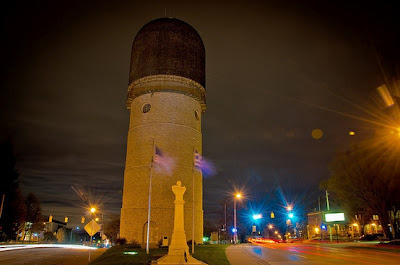
In the Shadow of the Water Tower will be a true-crime account of what were known as “The Coed Killings” or “The Rainy Day Murders.” In the late 1960s seven young women were brutally murdered by what seemed like a phantom killer who spirited their bodies away until they were found dead, scattered within a fifteen mile triangular drop zone in the countryside just north of Ypsilanti, Michigan.
An Eastern Michigan University senior, one semester away from earning his degree in elementary education, was charged with the sex-slaying of eighteen year-old, Karen Sue Beineman. John Norman Collins was indicted, tried, and found guilty of her murder in the first degree and given a life sentence in Michigan prisons.
Evidence in the six other murders was never heard. Law enforcement “had their man.” Because Collins was only convicted of one murder, the sobriquet of serial killer does not officially apply, but his story is fascinating none-the-less.
Beineman’s murder and the ensuing court case were not only local and national news stories, but they also attracted some international attention. In Canada, Collins is known as “The Canadian Hannibal Lector,” and in Great Britain, he is known as “The Ypsilanti Ripper.”
The trial started on July 20th, 1970 and by Saturday, the intense national media interest had shifted to the West Coast. The Sharon Tate and La Bianca murders had hit the front page. Charles Manson made better copy than John Norman Collins.
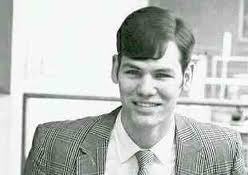 The Collins’ case has largely fallen through the cracks over time - literally. Washtenaw County Court documents for this case have been “purged.” Presently, my researcher and I are collecting every bit of information we can lay our hands on and compiling a photo bank to accompany the finished text, a feature missing from other treatments of this material.
The Collins’ case has largely fallen through the cracks over time - literally. Washtenaw County Court documents for this case have been “purged.” Presently, my researcher and I are collecting every bit of information we can lay our hands on and compiling a photo bank to accompany the finished text, a feature missing from other treatments of this material. We are piecing the story together from over 800 pages of news articles from the time, and we have just make arrangements through the Freedom of Information Act to get over 1,000 pages of documents from the Michigan Corrections Department regarding Collins and the forty-five years he has been behind prison bars. That story has never been told.
In addition to interviewing as many people as we can find who are still alive and were connected with this case, we also are interested in people who knew any of victims or their accused murderer, John Norman Collins. Some people came forward with information at the time but were ignored by the police. Some women have come forward recently for the first time and told their stories. I myself lived only one short block down the street from Collins and had several brushes with him.
In 1976, Edward Keyes rushed into print with The Michigan Murders, which told the then known basics of the case in a novelization of the real story. He took liberties by changing the names of the young female victims, their alleged murderer, and the witnesses other than the legal authorities.
Although it may have been the custom when it was written, in today’s tabloid world, protecting their real names doesn’t cut it anymore. These young women have been robbed of their identities, and the historical record has been subverted. I hope to remedy both situations.
If you have any information on these matters, I would like to hear from you.
Please contact me at:<www.gregoryafournier@gmail.com> or post a letter to:
FornologyPO Box 712821Santee, CA 92071-2821
Published on September 30, 2012 18:23
September 27, 2012
Five Guys Took A Boy Band Anthem And Created One Of The Best Romney Parodies, Hands Down

I am old enough to remember the "I like Ike" black and white television commercials of the Eisenhower political era. "I like Ike. You like Ike. Everybody likes Ike." They were done with simple line animation.Then there was the "Daisy" political commercial from the Johnson administration, used against Sen. Barry Goldwater to cast him as a war monger.
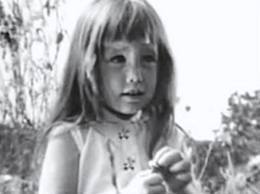
A little girl was shown pulling the petals off a daisy one by one until the last one - then a devastating scene of an exploding hydrogen bomb filling the television screen until it couldn't be contained anymore. This notorious television political ad was only shown once during the campaign, but it pulled no punches and was very effective. Today, it is considered a classic.
Basic politics hasn't changed much since Julius Caesar took twenty-three stab wounds from his colleagues in the Roman Forum on March 15th, 44 BC. But in the modern world, politicians must package and deliver their messages in a very different way. Simple butchery is no longer an accepted political practice, but the time honored "hatchet job" has been a staple in the politicians' bag of tricks since the beginning of participatory government.
During the last presidential political season, Tina Fey did a devastating parody of Sarah Palin, and Mrs. Palin was never taken seriously again by anybody. In this election year, the Republican's Greek chorus sang the same tune, "Show us your birth certificate." They tried to make high drama of it during their primary season and never made it past a dull roar.
What follows might become the most entertaining political message of this presidential year, depending on what your position is. Caution! Do not view the link below if you are offended by the view of hunks in trunks.
Five Guys Took A Boy Band Anthem And Created One Of The Best Romney Parodies, Hands Down | MoveOn.Org
Published on September 27, 2012 12:46
September 24, 2012
She Lived to Tell Her Tale - Don't Get in a Car with a Stranger - Part Two
 Note to the Reader: In my previous blog post, a University of Michigan alumna wrote me about narrowly escaping an attack and possibly much worse in 1969 when she accepted a ride from a stranger one rainy spring afternoon in Ann Arbor, Michigan.
Note to the Reader: In my previous blog post, a University of Michigan alumna wrote me about narrowly escaping an attack and possibly much worse in 1969 when she accepted a ride from a stranger one rainy spring afternoon in Ann Arbor, Michigan.In Part Two, I give her my response to the details of her email, as together, we try to work out "the who and the what" of this forty-four year-old incident.
*****
My response to [her name withheld by request],
I'm beside myself. You were very lucky indeed. The car John Norman Collins drove then was a 1968 silver Oldsmobile Cutlass, a four door, much like the car you described.
Picking up women on rainy days was his specialty.
Collins was a devout Catholic, I'm told by some of his friends at St. Clement's High School. Your religious talk with him may have saved your life. He was a confused and tormented person who must have felt like a condemned soul by then. How could he not?
[He may have felt like she was in a "state of grace" and that may have put him off his plan, though I didn't mention this theory to her.]
The "I was going to rape you" and "Say a prayer for Dave" remarks made my eyes well up. This is a direct link to the murder of Jane Mixer (third alleged victim of John Norman Collins), which another man is in jail doing life for. Look up Gary Earl Leiterman.
Now things get complicated. Someone used the name "David Johnson" when he answered the ride board ad in the basement of the (Michigan) Union. Jane Mixer wrote the name down on a page of her campus telephone directory. She disappeared that night and was found dead the next morning laid out neatly at Denton Cemetery in neighboring Wayne County.
[I didn't tell her that "David Johnson" was a Theta Chi fraternity brother of Collins who had "bad blood" between them. I'm thinking that Collins may have tried to implicate Johnson by throwing out a false lead.]
Your description of the driver fits Collins to a tee. A number of people have come forward with interesting stories, but what you have written here is by far the most useful and has the ring of truth.
May I use your story in some contextual way in my book? The fictionalized version of these murders did a disservice to the memory of the girls and to the history of this era. That's why I am writing this difficult book using real names and up-to-date information.
Thank you.
*****
Here is the message chain that followed:
Greg,
I really had no idea that your reply would link my incident with Collins. I had thought all these years that it was more than likely not related at all to the famous murders.
You may indeed use my story in your writings, but I would prefer that you not use my name.
*****
My response:
You may want to read The Red Parts, by Maggie Nelson. It is about the Gary Earl Leiterman case and what impact it had on Jane Mixer's family, thirty-five years after the fact. I have a hunch you will find it very interesting. I wrote a blog post on it. Search in the <fornology.blogspot.com> archives for it.
*****
Greg,
I found the archives and am reading the information. I read quite a lot about Leiterman yesterday. Funny that the first site I found when searching for him had his high school picture on it. It was a shock to see him just as I remember him. The more recent pictures would have been of no use to me.
I've been wondering if it would have done any good if I had reported the incident to authorities at the time. I was a terrible witness... no license plate number or make of car. I don't know what I would have told them. Maybe I could have described him.
I'm glad to know that he was convicted of Jane Mixer's murder. I only pray that somehow our close encounter had an influence on him. I really did pray for him off and on over all these years.
*****
My response:
I hate to admit this, but every big campus in America has a serious problem with rape and the abuse of young women. University authorities go to great lengths to downplay incidents, so they don't cause a panic or tarnish the reputation of the institution.
Just last summer, there was a serial rapist in Ann Arbor. Don't beat yourself up about not going to the police; the report would have been of little use to them. DNA nailed Leiterman; he was an unknown quantity at the time. I feel a sense of satisfaction at helping you solve your nagging mystery. We did it together!
*****
Greg,
And thanks for that. I am grateful to have closure and to know that he is behind bars. There is no question in my mind that he killed the girl, grandfatherly persona be damned.
*****
And so it goes.... this wasn't the outcome that I had anticipated, but as a seeker of truth, I'm very pleased and satisfied with the outcome.
If anyone has information about the Michigan murders or about John Norman Collins, please don't hesitate to contact me at www.gregoryafournier@gmail.com or mail me at:
FornologyPO Box 712821Santee, CA 92072-2821
Published on September 24, 2012 18:57
September 22, 2012
She Lived to Tell Her Tale - Don't Get in a Car with a Stranger! - Part One
To the Reader: For the first time in this blog, I am running an email I received from a former University of Michigan student who wrote me several days ago in response to my call for information on the John Norman Collins' series of sex slayings in the late Sixties.
I found her story compelling reading. She was having a bad day and accepted a ride from a stranger on a rainy day at the height of the "Co-Ed Killings" in 1969. In part one of this two part post, she tells her own story. My response to her and the surprising result will appear in part two in several days.
I have her permission to run her letter.
*****
 Dear Mr. Fournier,
Dear Mr. Fournier,
In 1969, I was a sophomore coed living in the Alpha Chi Omega house on Washtenaw [Ave]. On a rainy spring afternoon I was walking with my umbrella up on University [Ave], a block or two from the corner of Washtenaw and University. A large, 4-door sedan (in my memory it was a Pontiac or something of that size, heavy and solid) pulled up beside me, and a man opened the passenger door and offered me a ride.
In my wildest dreams, I never imagined that I would get into a car with a stranger, but for some reason that day I did. I had some sort of boyfriend issue at the time, so insignificant that I can't remember what it was about. I had been to St. Mary's Chapel for a little prayer time and was walking home in a dejected state. I'm sure my body language marked me as a target for the driver of the car.
As I closed the door, I got a sinking feeling that I was doing the stupidest thing I would ever do in my life. He asked me why I was so down and where I was going. I said I had just come out of St. Mary's and was heading out Washtenaw. He made the turn onto Washtenaw and drove carefully. I wondered if he would stop at my corner or continue on past it toward Ypsilanti. I remember thinking if he didn't stop, or if he speeded up, I would open the car door and take my chances and leap to the pavement. I would definitely have done it. It crossed my mind to take my book bag with me.
We talked for the few minutes I was in the car about my praying and how I thought God would help me with my troubles because I was close to Him and was used to going to Him for consolation and communion. To my great relief, at the corner of Cambridge and Washtenaw he slowed the car and stopped.
As I opened the door and thanked him for the lift, he turned to me and said, "I was going to rape you, but I changed my mind." I pretended to laugh, as if it was a joke, but I knew he was serious. He then said to me. "The next time you are in church, say a prayer for Dave." I promised to do so as I closed the car door behind me and breathed a deep sigh of relief.
I was really not aware of the murders in the area at the time. I didn't connect this incident with local news. I've never forgotten the exact words he said to me, or the feeling that I had narrowly escaped from a very serious situation.
"Dave" was dark haired with a slick-backed haircut that was right out of central casting for the "Sopranos". I remember a prominent Roman nose and a "city clothes" style unlike the casual jeans and flannel shirt look of the day, a contrast to student attire. I really couldn't provide any better description of him or of the car, even at the time.
I was reading your blog today, asking for any small details. I don't know if this is helpful or not. I never reported it to any authority, although I used the story to scare the crap out of my own two girls as they went off to college.
(Name withheld by request)
*****
Part Two will run in a few days.

I found her story compelling reading. She was having a bad day and accepted a ride from a stranger on a rainy day at the height of the "Co-Ed Killings" in 1969. In part one of this two part post, she tells her own story. My response to her and the surprising result will appear in part two in several days.
I have her permission to run her letter.
*****
 Dear Mr. Fournier,
Dear Mr. Fournier,In 1969, I was a sophomore coed living in the Alpha Chi Omega house on Washtenaw [Ave]. On a rainy spring afternoon I was walking with my umbrella up on University [Ave], a block or two from the corner of Washtenaw and University. A large, 4-door sedan (in my memory it was a Pontiac or something of that size, heavy and solid) pulled up beside me, and a man opened the passenger door and offered me a ride.
In my wildest dreams, I never imagined that I would get into a car with a stranger, but for some reason that day I did. I had some sort of boyfriend issue at the time, so insignificant that I can't remember what it was about. I had been to St. Mary's Chapel for a little prayer time and was walking home in a dejected state. I'm sure my body language marked me as a target for the driver of the car.
As I closed the door, I got a sinking feeling that I was doing the stupidest thing I would ever do in my life. He asked me why I was so down and where I was going. I said I had just come out of St. Mary's and was heading out Washtenaw. He made the turn onto Washtenaw and drove carefully. I wondered if he would stop at my corner or continue on past it toward Ypsilanti. I remember thinking if he didn't stop, or if he speeded up, I would open the car door and take my chances and leap to the pavement. I would definitely have done it. It crossed my mind to take my book bag with me.
We talked for the few minutes I was in the car about my praying and how I thought God would help me with my troubles because I was close to Him and was used to going to Him for consolation and communion. To my great relief, at the corner of Cambridge and Washtenaw he slowed the car and stopped.
As I opened the door and thanked him for the lift, he turned to me and said, "I was going to rape you, but I changed my mind." I pretended to laugh, as if it was a joke, but I knew he was serious. He then said to me. "The next time you are in church, say a prayer for Dave." I promised to do so as I closed the car door behind me and breathed a deep sigh of relief.
I was really not aware of the murders in the area at the time. I didn't connect this incident with local news. I've never forgotten the exact words he said to me, or the feeling that I had narrowly escaped from a very serious situation.
"Dave" was dark haired with a slick-backed haircut that was right out of central casting for the "Sopranos". I remember a prominent Roman nose and a "city clothes" style unlike the casual jeans and flannel shirt look of the day, a contrast to student attire. I really couldn't provide any better description of him or of the car, even at the time.
I was reading your blog today, asking for any small details. I don't know if this is helpful or not. I never reported it to any authority, although I used the story to scare the crap out of my own two girls as they went off to college.
(Name withheld by request)
*****
Part Two will run in a few days.
Published on September 22, 2012 06:52
She Lived to Tell Her Tale - Don't Get in a Car with a Stranger!
To the Reader: For the first time in this blog, I am running a email I received from a former University of Michigan student who wrote me several days ago in response to my call for information on the John Norman Collins' series of sex slayings in the late Sixties.
I found her story compelling reading. She was having a bad day and accepted a ride from a stranger on a rainy day at the height of the "Co-Ed Killings" in 1969. In part one of this two part post, she tells her own story. My response to her and the surprising result will appear in part two in several days.
I have her permission to run her letter.
*****
 Dear Mr. Fournier,
Dear Mr. Fournier,
In 1969, I was a sophomore coed living in the Alpha Chi Omega house on Washtenaw [Ave]. On a rainy spring afternoon I was walking with my umbrella up on University [Ave], a block or two from the corner of Washtenaw and University. A large, 4-door sedan (in my memory it was a Pontiac or something of that size, heavy and solid) pulled up beside me, and a man opened the passenger door and offered me a ride.
In my wildest dreams, I never imagined that I would get into a car with a stranger, but for some reason that day I did. I had some sort of boyfriend issue at the time, so insignificant that I can't remember what it was about. I had been to St. Mary's Chapel for a little prayer time and was walking home in a dejected state. I'm sure my body language marked me as a target for the driver of the car.
As I closed the door, I got a sinking feeling that I was doing the stupidest thing I would ever do in my life. He asked me why I was so down and where I was going. I said I had just come out of St. Mary's and was heading out Washtenaw. He made the turn onto Washtenaw and drove carefully. I wondered if he would stop at my corner or continue on past it toward Ypsilanti. I remember thinking if he didn't stop, or if he speeded up, I would open the car door and take my chances and leap to the pavement. I would definitely have done it. It crossed my mind to take my book bag with me.
We talked for the few minutes I was in the car about my praying and how I thought God would help me with my troubles because I was close to Him and was used to going to Him for consolation and communion. To my great relief, at the corner of Cambridge and Washtenaw he slowed the car and stopped.
As I opened the door and thanked him for the lift, he turned to me and said, "I was going to rape you, but I changed my mind." I pretended to laugh, as if it was a joke, but I knew he was serious. He then said to me. "The next time you are in church, say a prayer for Dave." I promised to do so as I closed the car door behind me and breathed a deep sigh of relief.
I was really not aware of the murders in the area at the time. I didn't connect this incident with local news. I've never forgotten the exact words he said to me, or the feeling that I had narrowly escaped from a very serious situation.
"Dave" was dark haired with a slick-backed haircut that was right out of central casting for the "Sopranos". I remember a prominent Roman nose and a "city clothes" style unlike the casual jeans and flannel shirt look of the day, a contrast to student attire. I really couldn't provide any better description of him or of the car, even at the time.
I was reading your blog today, asking for any small details. I don't know if this is helpful or not. I never reported it to any authority, although I used the story to scare the crap out of my own two girls as they went off to college.
(Name withheld by request)
*****
Part Two will run in a few days.

I found her story compelling reading. She was having a bad day and accepted a ride from a stranger on a rainy day at the height of the "Co-Ed Killings" in 1969. In part one of this two part post, she tells her own story. My response to her and the surprising result will appear in part two in several days.
I have her permission to run her letter.
*****
 Dear Mr. Fournier,
Dear Mr. Fournier,In 1969, I was a sophomore coed living in the Alpha Chi Omega house on Washtenaw [Ave]. On a rainy spring afternoon I was walking with my umbrella up on University [Ave], a block or two from the corner of Washtenaw and University. A large, 4-door sedan (in my memory it was a Pontiac or something of that size, heavy and solid) pulled up beside me, and a man opened the passenger door and offered me a ride.
In my wildest dreams, I never imagined that I would get into a car with a stranger, but for some reason that day I did. I had some sort of boyfriend issue at the time, so insignificant that I can't remember what it was about. I had been to St. Mary's Chapel for a little prayer time and was walking home in a dejected state. I'm sure my body language marked me as a target for the driver of the car.
As I closed the door, I got a sinking feeling that I was doing the stupidest thing I would ever do in my life. He asked me why I was so down and where I was going. I said I had just come out of St. Mary's and was heading out Washtenaw. He made the turn onto Washtenaw and drove carefully. I wondered if he would stop at my corner or continue on past it toward Ypsilanti. I remember thinking if he didn't stop, or if he speeded up, I would open the car door and take my chances and leap to the pavement. I would definitely have done it. It crossed my mind to take my book bag with me.
We talked for the few minutes I was in the car about my praying and how I thought God would help me with my troubles because I was close to Him and was used to going to Him for consolation and communion. To my great relief, at the corner of Cambridge and Washtenaw he slowed the car and stopped.
As I opened the door and thanked him for the lift, he turned to me and said, "I was going to rape you, but I changed my mind." I pretended to laugh, as if it was a joke, but I knew he was serious. He then said to me. "The next time you are in church, say a prayer for Dave." I promised to do so as I closed the car door behind me and breathed a deep sigh of relief.
I was really not aware of the murders in the area at the time. I didn't connect this incident with local news. I've never forgotten the exact words he said to me, or the feeling that I had narrowly escaped from a very serious situation.
"Dave" was dark haired with a slick-backed haircut that was right out of central casting for the "Sopranos". I remember a prominent Roman nose and a "city clothes" style unlike the casual jeans and flannel shirt look of the day, a contrast to student attire. I really couldn't provide any better description of him or of the car, even at the time.
I was reading your blog today, asking for any small details. I don't know if this is helpful or not. I never reported it to any authority, although I used the story to scare the crap out of my own two girls as they went off to college.
(Name withheld by request)
*****
Part Two will run in a few days.
Published on September 22, 2012 06:52
September 18, 2012
Ford Henchman, Harry Bennett, and His Hidden Estate in Ypsilanti
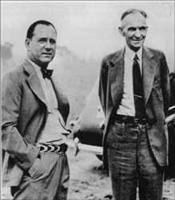 Harry Bennett and Henry Ford
Harry Bennett and Henry FordDuring the turbulent 1920's and 1930's, the automobile manufactures stood firm against trade unionism. Government and industry viewed the American labor movement as European socialism. With the overthrow of the Czar in Russia in 1919, the fear of communism was a tangible political reality for America.
The Ford Motor Company was having none of it. On the Ford payroll was one Harry Bennett. Harry had a special assignment - he was to coordinate resistance against the United Auto Workers and their leaders like Walter Reuther, who had his head busted open with a tire thumper while striking against Ford at "The Battle of the Overpass" across Miller Road. Bennett had hired local gangsters to rough up the strikers or worst. He was Henry Ford's hatchet man.
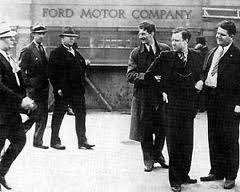 Thugs closing in on Reuther and UAW officialsHarry Bennett wasn't popular, but he was powerful. After a couple of death threats, Ford had a fortified retreat built for Bennett in a remote spot just outside of Ypsilanti near Geddes and LeForge roads.
Thugs closing in on Reuther and UAW officialsHarry Bennett wasn't popular, but he was powerful. After a couple of death threats, Ford had a fortified retreat built for Bennett in a remote spot just outside of Ypsilanti near Geddes and LeForge roads.The property was surrounded by an iron fence and gun turrets were evident in the design of the estate, all made from Ford cement and steel. There were several out buildings and there was a compound on the sprawling property for lions and tigers, which it was said were there to protect the grounds if need be.They weren't there to represent Detroit's professional sports teams.
The Huron River abutted the property, so Bennett could made a hasty retreat through an escape tunnel if he found himself under attack. He had a boathouse with a boat gassed up and ready to go on a moment's notice. In an emergency, it would take only an hour to reach Lake Erie.
See the link for more information. http://www.youtube.com/watch?v=Z0jyOf...
Published on September 18, 2012 20:46
September 15, 2012
Landmarks of the Ypsilanti "Co-ed Killer" Case
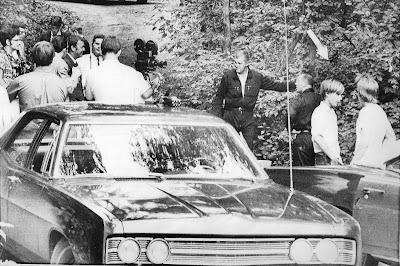 Site where Karen Sue Beineman's body was found in Ann Arbor Township - July 26, 1969.
Site where Karen Sue Beineman's body was found in Ann Arbor Township - July 26, 1969.The last of a series of Michigan murders known as "The Co-ed Killings" or the "Rainy Day Murders" occurred on July 23, 1969, in the Ypsilanti/Ann Arbor area. Karen Sue Beineman's nude battered body was found three days later only fifteen feet from Riverside Dr. in Ann Arbor Township laying face down in a shallow gully running through a small ravine.
The remote, semi-wooded farm country of Superior Township just north of Ypsilanti proved to be the favored dump site for six of the seven bodies of young women thought to have been victims of the same psychotic killer. The drop zone comprised a fifteen mile triangular area.
For two long years, Washtenaw County law enforcement was baffled by these savage murders. With few if any clues left behind at the crime scenes, it wasn't until the fourth murder that police were certain they had a "multiple murder" on the loose. The term "serial killer" hadn't been coined until the Son of Sam trial in 1977 by FBI agent, Robert Ressler.
As the body count rose, forensic investigators indicated that the murderer killed his prey in one place and disposed of the bodies someplace else where they would be easily found. There was evidence to suggest that the killer had returned to a couple of the sites and may have even moved the bodies where they might be more easily found. Other facts concerning the brutality and mutilation of the vicims' bodies showed a disturbed and angry individual was at work who was striking with greater frequency.
Several years ago, a videographer know as Retrokimmer made a brief YouTube documentary of many of the "landmarks" associated with Ypsilanti's "Rainy Day Murders" of 1967-1969. Most of the information is accurate. One notable exception concerns The John Norman Collins house which is currently not a fraternity house; it is a sorority house which is even more ironic.
I am writing a new account of these murders and their aftermath called, In the Shadow of the Water Tower. If you have any new information on this case, I want to hear from you. Details, no matter how small they appear to you, may help me connect some of the loose dots of this case.
I can be reached at gregoryafournier@gmail.com or you can mail me at Fornology, PO Box 712821, Santee, CA 92072.
http://www.youtube.com/watch?v=3CvoO4T1qLQ&feature=related
Published on September 15, 2012 14:45
September 9, 2012
In the Shadow of the Water Tower - The John Norman Collins' Story
 The Ypsilanti Water Tower
The Ypsilanti Water TowerForty-five years ago, a series of seven horrific sex slayings of young women began in the Ypsilanti, Michigan area. The first mutilation murder was of Mary Fleszar (19), an Eastern Michigan University coed majoring in accounting. On July 9, 1967, Mary went for a walk on a hot summer evening and never returned to her apartment. A month later her, body was found in a fallow field in an advanced stage of decomposition. It took dental records to identify her.
This was the worst sight most of the detectives called to the scene had ever witnessed. Everyone involved in this gruesome episode hoped that it was an isolated incident committed by a deranged transient, but it appeared that the murderer had returned to the scene twice, maybe three times.This suggested that the killer was someone local.
Almost a year passed before another brutal murder of an EMU coed occurred on July 1, 1968. Twenty year-old Joan Schell was last seen just before midnight on June 30. When her body was discovered a week later, it had been mutilated and dumped not far from where Mary Fleszar's body had been dumped, just north of Ypsilanti. Police began to worry they had a maniac murderer on their hands - maybe two. Not wanting to cause the public to panic, law enforcement downplayed any connection between the two murders, but some police detectives believed differently.
Eight months later on March 20, 1969, a third murder was discovered neatly placed in a cemetery in Denton Township just inside the Wayne County line with Washtenaw County. Jane Mixer was a twenty-three year-old University of Michigan coed who had identification in her belongings. The coroner sent the body to University Hospital morgue in Washtenaw County. Now the press showed a deeper interest in connecting the three murders. But police thought things were fundamentally different about this murder.
Then a mere five days later, Maralynn Skelton (16) was last seen hitch-hiking in front of Arborland Shopping Center on March 25. When her body was found, there was such an overkill, that some cops felt her murder might have been a drug related message murder for talking with the police. Maralynn was a drug informant and may have owed money to some people. Her body was found approximately in the same area as the first two, north of Ypsilanti in Superior Township.
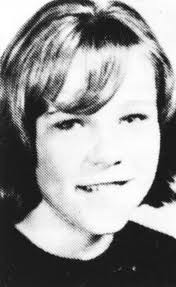 Dawn BasomDawn Basom, a local thirteen year-old Ypsi junior high school student, went missing while walking home on April 15 just before dark. She walked part of the way home on the railroad tracks which was and is the local shortcut. The next day, her body was found in the same vicinity as the previous three of four murders of young women in the area.
Dawn BasomDawn Basom, a local thirteen year-old Ypsi junior high school student, went missing while walking home on April 15 just before dark. She walked part of the way home on the railroad tracks which was and is the local shortcut. The next day, her body was found in the same vicinity as the previous three of four murders of young women in the area.Only twenty-two days separated the killings of the youngest teenage girls. The public was officially panicked and outraged. What were the police doing? Did the area harbor a multiple murderer? Where and when would he, or they, strike next? Nobody felt safe.
Then seven weeks passed until Alice Kalom (23), a University of Michigan student was last seen on June 7,1969. She was supposed to meet some friends at a place called The Depot House who said she never showed up. Others at the Depot House said they thought they saw a girl who looked like her dancing with a young, long haired guy, but they couldn't be sure. Just another one of the many unanswered questions and conflicting evidence the police were struggling with.
Things were getting red hot for the killer, whoever he might be. A female accomplice might be involved or maybe a copycat killer or killers. The police had theories but no suspect. The reality was that the police were no closer to solving any of these cases than ever, but they were scouring the town searching for the maniac killer. By this time, most experts believed the killer acted alone in the commission of these power and control murders.
There was a pause of sixty-four days until another EMU coed disappeared from the area. On Thursday, July 23, Karen Sue Beineman was seen driving off on a motorcycle with a young man she had just met. She took a ride with a stranger despite all the warnings she had heard from the university and the appeals made in the local media by police. Her body was found laying face down in a gully three days later on Sunday, the 26th, only a mile away from the police task force command center. Law enforcement officials were desperate for a break in the case and were about to get two major ones.
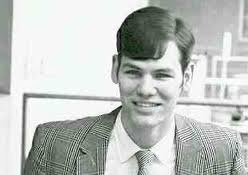 John Norman CollinsA twenty-three year-old EMU student, John Norman Collins was arrested on August 1, 1969, for the mutilation sex slaying of Karen Sue Beineman. John Norman Collins was convicted of first degree murder on August 28, 1970 to life in prison.
John Norman CollinsA twenty-three year-old EMU student, John Norman Collins was arrested on August 1, 1969, for the mutilation sex slaying of Karen Sue Beineman. John Norman Collins was convicted of first degree murder on August 28, 1970 to life in prison.But what of the other murders? These cases were shelved and never prosecuted. And an additional murder surfaced in Salinas, California, of Roxie Ann Phillips (17) of Milwaukie, Oregon. Roxie went missing on June 30, 1969, and her body was found on July 13, in Pescarado Canyon. Collins had been "visiting" in Salinas and was linked to her. A Monterey County Grand Jury brought an indictment against Collins on April 16, 1970, for her murder.
All of these cases are still considered open, so evidence is not available and is closely guarded by Michigan State Police in Lansing. The official Washtenaw County Courthouse case transcripts have been "purged" from their records, and understandably, family members of the victims are reluctant to talk, including the family of John Norman Collins.
Apparently there was a point of diminishing returns for more jurisprudence. One conviction was as good as seven. The police got their man off the streets, the rash of sex slayings ceased, so the other cases were never pursued. This was the most expensive case in Washtenaw County history. Some people may not want this story re-examined, but history demands a full accounting.
As a writer and researcher, I am left with archival news clippings and the memories of people who knew the victims and the alleged serial killer, John Norman Collins. Remember, he was only convicted of one murder and officially doesn't qualify for the title of serial killer.
If anyone has information pertaining to this case, photos, or other relevant information, please send me a message at www.gregoryafournier@gmail.com or write me at Fornology, PO Box 712821, Santee, CA 92072.
All replies will be held in strictest confidence. I want to collect as many facts about this case as I possibly can for the true crime book I'm writing entitled In the Shadow of the Water Tower. Here's your chance to contribute information.
Published on September 09, 2012 09:47
September 5, 2012
John Norman Collins' Nemesis - Washtenaw Country Sheriff Douglas J. Harvey - Part Two
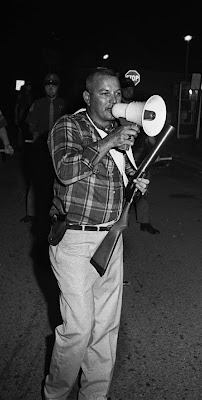 Sheriff Harvey with Tear Gas LauncherOn July 9, 1967, a nineteen year old Eastern Michigan University business student majoring in accounting went missing after an evening walk.
Sheriff Harvey with Tear Gas LauncherOn July 9, 1967, a nineteen year old Eastern Michigan University business student majoring in accounting went missing after an evening walk.Mary Fleszar's badly decomposed body was discovered thirty days later by two thirteen year old boys laying in a field of shoulder high weeds on the site of an abandoned farm just north of Ypsilanti.
Her brutal murder, and the six that would follow, shocked the residents of Ypsilanti and Ann Arbor, two university campus towns connected by Washtenaw Avenue. For two long years, the brutal sex slayings of young woman took place.
The elusive serial killer appeared to have criminal intuition and easily evaded capture. In the minds of some people, the murderer seemed to have an almost "spectral" quality.
Every lawman in Washtenaw County made the capture and conviction of this deranged killer of young women their number one priority, but none more than Washtenaw County Sheriff Douglas J. Harvey.
At a Kiwanis Club "Morning Edition" breakfast in Ann Arbor on June 29, 2011, the former sheriff reminisces on this forty-five year old case. Not since Odysseus has anyone enjoyed telling his story more.
http://www.youtube.com/watch?v=RK_-c1vqe8Q
Published on September 05, 2012 08:28



